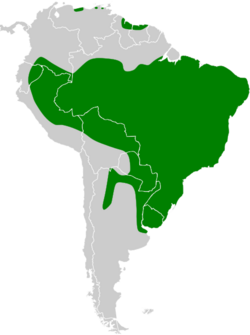Biology:Rufous-sided crake
| Rufous-sided crake | |
|---|---|
| Scientific classification | |
| Domain: | Eukaryota |
| Kingdom: | Animalia |
| Phylum: | Chordata |
| Class: | Aves |
| Order: | Gruiformes |
| Family: | Rallidae |
| Genus: | Laterallus |
| Species: | L. melanophaius
|
| Binomial name | |
| Laterallus melanophaius (Vieillot, 1819)
| |

| |
The rufous-sided crake (Laterallus melanophaius) is a species of bird in subfamily Rallinae of family Rallidae, the rails, gallinules, and coots.[2][3] It is found in every mainland South American country except Chile.[4]
Taxonomy and systematics
The rufous-sided crake has two subspecies, the nominate L. m. melanophaius and L. m. oenops.[2] What is now the white-throated crake (L. albigularis) was for a time treated as a third subspecies.[5]
Description
The rufous-sided crake is 14 to 18 cm (5.5 to 7.1 in) long and weighs about 50 to 60 g (1.8 to 2.1 oz). The sexes are alike. Both subspecies' bills have a gray maxilla with a pea green cutting edge and a pale pea green mandible with a white tip. Their legs and feet are light gray brown to olive brown. The nominate subspecies has dark olive brown upperparts with a gray tinge around the eye. The face and sides of the breast are rufous to cinnamon rufous. The throat and center of the breast are white, the flanks and belly barred white and blackish brown, and the undertail coverts are dark cinnamon rufous. Subspecies L. m. oenops is similar to the nominate, but has paler upperparts and is rufous on the forecrown and around the eye.[6]
Distribution and habitat
The nominate subspecies of rufous-sided crake has much the larger range of the two. It is found from coastal Venezuela east through the Guianas and separately from central and eastern Brazil south through eastern Bolivia, Paraguay, and Uruguay into northern Argentina. Subspecies L. m. oenops is found from southern Colombia south through eastern Ecuador into eastern Peru and east into western Brazil. The species primarily inhabits freshwater marshes and similar landscapes such as flooded pastures and the edges of ponds and oxbow lakes .[2][6]
Behavior
Movement
The rufous-sided crake is not known to migrate.[6]
Feeding
The rufous-sided crake usually forages in dense grassy vegetation but also in the open close to cover. It forages in mud and vegetation for its primary diet of small arthropods; seeds and leaves are also eaten.[6]
Breeding
Only fragments are known about the rufous-sided crake's breeding biology. Its nesting season(s) are not known for most of its range but include September and October in Argentina. Its nest is a globe of leaves lined with leaf shreds, dry grass, and feathers. It is placed on or just above the ground and has a side entrance. The incubation period is about 20 days.[6]
Vocalization
The rufous-sided crake's song is "a rubbery musical trill" much like those of other Laterallus crakes. Its calls include ""high-pitched tinkling calls[,] [a] short treeeeeng[, and] a harsh, descending djreer."[6]
Status
The IUCN has assessed the rufous-sided crake as being of Least Concern. It has a very large range but its population size and trend are not known. No immediate threats have been identified.[1] It is thought uncommon to locally common in Ecuador and fairly common in Peru. "Human activity has little short-term direct effect on Rufous-sided Crake, other than the local effects of habitat destruction."[6]
References
- ↑ 1.0 1.1 BirdLife International (2016). "Rufous-sided Crake Laterallus melanophaius". IUCN Red List of Threatened Species 2016: e.T22692337A93348780. doi:10.2305/IUCN.UK.2016-3.RLTS.T22692337A93348780.en. https://www.iucnredlist.org/species/22692337/93348780. Retrieved 28 November 2022.
- ↑ 2.0 2.1 2.2 Gill, Frank; Donsker, David; Rasmussen, Pamela, eds (August 2022). "Flufftails, finfoots, rails, trumpeters, cranes, limpkin". IOC World Bird List Version 12.2. International Ornithologists' Union. https://www.worldbirdnames.org/new/bow/flufftails/.
- ↑ HBW and BirdLife International (2021) Handbook of the Birds of the World and BirdLife International digital checklist of the birds of the world. Version 6. Available at: http://datazone.birdlife.org/userfiles/file/Species/Taxonomy/HBW-BirdLife_Checklist_v6_Dec21.zip retrieved August 7, 2022
- ↑ Remsen, J. V., Jr., J. I. Areta, E. Bonaccorso, S. Claramunt, A. Jaramillo, D. F. Lane, J. F. Pacheco, M. B. Robbins, F. G. Stiles, and K. J. Zimmer. Version 24 July 2022. Species Lists of Birds for South American Countries and Territories. https://www.museum.lsu.edu/~Remsen/SACCCountryLists.htm retrieved July 24, 2022
- ↑ Remsen, J. V., Jr., J. I. Areta, E. Bonaccorso, S. Claramunt, A. Jaramillo, D. F. Lane, J. F. Pacheco, M. B. Robbins, F. G. Stiles, and K. J. Zimmer. Version 24 July 2022. A classification of the bird species of South America. American Ornithological Society. https://www.museum.lsu.edu/~Remsen/SACCBaseline.htm retrieved July 24, 2022
- ↑ 6.0 6.1 6.2 6.3 6.4 6.5 6.6 Schulenberg, T. S. (2020). Rufous-sided Crake (Laterallus melanophaius), version 1.0. In Birds of the World (T. S. Schulenberg, Editor). Cornell Lab of Ornithology, Ithaca, NY, USA. https://doi.org/10.2173/bow.ruscra1.01 retrieved November 28, 2022
Wikidata ☰ Q1267636 entry
 |


